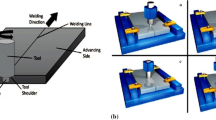Abstract
Residual stress is lower in friction stir welding (FSW) compared with other melting weldment processes. This is due to being solid-state process in its nature. There are several advantages in utilizing stir welding process. Lower fluctuation and shrinkage in weldment metal-enhanced mechanical characteristics, less defects, and ability to weld certain metals otherwise impractical by other welding processes are to name just a few of these advantages. These have caused an ever increasing attention by the concerned to the process of FSW. In this investigation, three-dimensional numerical simulation of friction stir welding was concerned to study the impact of tool moving speed in relation with heat distribution as well as residual stress. Simulation was composed of two stages. Firstly, thermal behavior of the piece while undergoing the welding process was studied. Heat is generated due to the friction between tool and the piece being welded. In the second stage, attained thermal behavior of the piece from previous stage is considered as inlet heat of an elasto-plastic, thermo-mechanical model for the prediction of residual stress. Also, in the second stage, tool is eliminated and residual stress distribution is found after complete cooling of the piece and disassembly of the clamp. Material characteristic are introduced into the proposed model as temperature-dependent parameters. Obtained residual indicate that heat distribution along thickness varies and is asymmetrical enormously. Moreover, longitudinal residual stress in the weld which increases as speed of process and tool movement ascends. In the prediction of results of residual stress, only heat impact was studied. This was recognized as the main element causing minor difference in results obtained for simulation in comparison with that of actual experiment.
Similar content being viewed by others
References
Zhang Z, Zhang HW (2008) A fully coupled thermo-mechanical model of friction stir welding. Int J Adv Manuf Technol 37:279–293
Cho JH, Boyce DE, Dawson PR (2005) Modeling strain hardening and texture evolution in friction stir welding of stainless steel. Mater Sci Eng 398:146–163
Nandan R, DebRoy T, Bhadeshia HKDH (2008) Recent advances in friction-stir welding—process, weldment structure and properties. Prog Mater Sci 53:980–1023
Chao YJ, Qi X, Tang W (2003) Heat transfer in friction stir welding—experimental and numerical studies. J Manuf Sci Eng 125:138–145
Schmidt HB, Hattel JH (2008) Thermal modelling of friction stir welding. Scr Mater 58:332–337
Mandal S, Williamson K (2006) A thermo-mechanical hot channel approach for friction stir welding. J Mater Process Technol 174:190–194
Song M, Kovacevic R (2003) Thermal modeling of friction stir welding in a moving coordinate system and its validation. Int J Mach Tools Manuf 43:605–615
Zhang HW, Zhang Z, Chen JT (2005) The finite element simulation of the friction stir welding process. Mater Sci Eng 403:340–348
Zhang Z, Zhang HW (2007) Material behaviors and mechanical features in friction stir welding process. Int J Adv Manuf Technol 35:86–100
Zhang Z, Zhang HW (2009) Numerical studies on controlling of process parameters in friction stir welding. J Mater Process Technol 209:241–270
Nandan R, Roy GG, Debroy T (2006) Numerical simulation of three-dimensional heat transfer and plastic flow during friction stir welding. Metall Mater Trans 37A:1247–1259
Nandan R, Roy GG, Lienert TJ, Debroy T (2006) Numerical modelling of 3D plastic flow and heat transfer during friction stir welding of stainless steel. Sci Technol Weld Joining 11:526–537
John R, Jata KV, Sadananda K (2003) Residual stress effects on near-threshold fatigue crack growth in friction stir welds in aerospace alloys. Int J Fatigue 25:939–948
Bussu G, Irving PE (2003) The role of residual stress and heat affected zone properties on fatigue crack propagation in friction stir welded 2024-T351 aluminium joints. Int J Fatigue 25:77–88
Khandkar MZH, Khan JA, Reynolds AP, Sutton MA (2006) Predicting residual thermal stresses in friction stir welded metals. J Mater Process Technol 174:195–203
Chen CM, Kovacevic R (2003) Finite element modeling of friction stir welding—thermal and thermomechanical analysis. Int J Mach Tools Manuf 43:1319–1326
Buffa G, Hua J, Shivpuri R, Fratini L (2006) A continuum based FEM model for friction stir welding—model development. Mater Sci Eng 419:389–396
Rajesh SR, Bang HS, Chang WS, Kim HJ, Bang HS, Oh CI, Chu JS (2007) Numerical determination of residual stress in friction stir weld using 3D-analytical model of stir zone. J Mater Process Technol 187–188:224–226
Peel M, Steuwer A, Preuss M, Withers PJ (2003) Microstructure, mechanical properties and residual stresses as a function of welding speed in aluminium AA5083 friction stir welds. Acta Mater 51:4791–4801
Feng Z, Wang XL, David SA, Sklad P (2004) Modeling of residual stresses and property distributions in friction stir welding of aluminum alloy 6061-T6. In: 5th International Friction Stir Welding Symposium, Metz, France
Zhu XK, Chao YJ (2004) Numerical simulation of transient temperature and residual stresses in friction stir welding of 304L stainless steel. J Mater Process Technol 146:263–272
Soundararajan V, Zekovic S, Kovacevic R (2005) Thermo-mechanical model with adaptive boundary conditions for friction stir welding of Al 6061. Int J Mach Tools Manuf 45:1577–1587
Wong JC (2008) The correspondence between experimental data and computer simulation of friction stir welding (FSW). Master of Science thesis, Department of Mechanical and Aerospace Engineering, Morgantown, West Virginia, USA
ABAQUS analysis user’s manual, version 6.7, ABAQUS Inc. 2007
Author information
Authors and Affiliations
Corresponding author
Rights and permissions
About this article
Cite this article
Riahi, M., Nazari, H. Analysis of transient temperature and residual thermal stresses in friction stir welding of aluminum alloy 6061-T6 via numerical simulation. Int J Adv Manuf Technol 55, 143–152 (2011). https://doi.org/10.1007/s00170-010-3038-z
Received:
Accepted:
Published:
Issue Date:
DOI: https://doi.org/10.1007/s00170-010-3038-z



